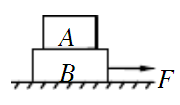问题
选择题
叠放在一起的A、B两物体在水平力F的作用下,沿水平面以某一速度匀速运动,现突然将作用在B上的力F改为作用在A上,并保持大小和方向不变,如图所示,则关于A、B的运动状态可能为( )

A.一起匀速运动 B.一起加速运动
C.A加速,B减速 D.A加速,B匀速
答案
AC
题目分析:据题意,拉力F作用在B上时做匀速运动,则有: ;此时把F作用在A上,如果
;此时把F作用在A上,如果 ,则A物体做匀加速直线运动,A、B发生相对滑动,A物体作用在B物体上的摩擦力有:
,则A物体做匀加速直线运动,A、B发生相对滑动,A物体作用在B物体上的摩擦力有: ,则B物体做减速运动;如果
,则B物体做减速运动;如果 ,则A、B相对静止,且A、B整体有:
,则A、B相对静止,且A、B整体有: ,则A、B一起匀速运动。故选项A、C正确。
,则A、B一起匀速运动。故选项A、C正确。
